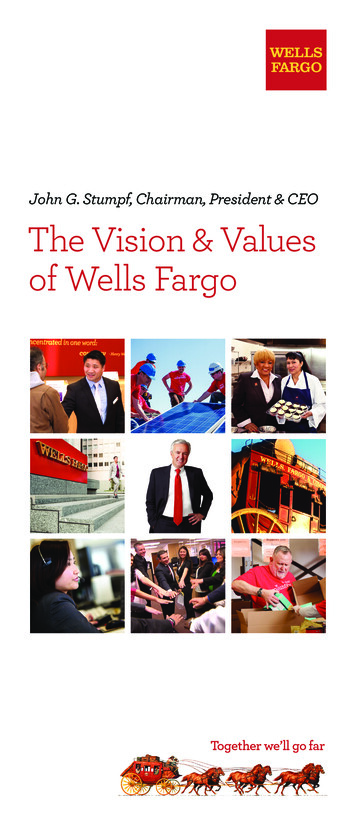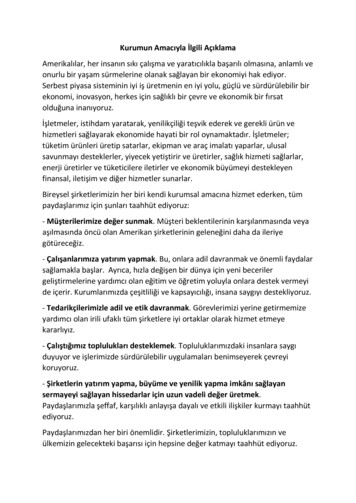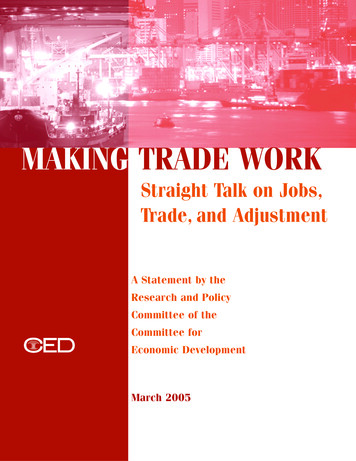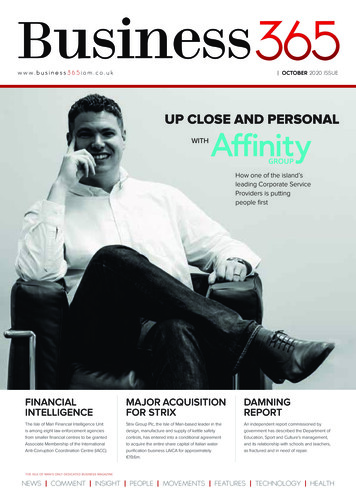
Transcription
John G. Stumpf, Chairman, President & CEOThe Vision & Valuesof Wells Fargo
“Regardless ofour growing size,scope and reach,our commonvision and distinctvalues formthe fabric thatholds us togetherwherever we are,whatever we do.”2
What’s inside?2Welcome4Our vision6Our valuesPeople as a competitive advantageEthicsWhat’s right for customersDiversity and inclusionLeadership14Our cultureOne Wells Fargo“Wow!”Disciplined, responsible lendingManaging risksManaging our resourcesCulture first, size second22 Our strategyThe customer value of cross-sellingTechnology: The personal touchCustomer-centric, not product-centricOur brandOur opportunities28 Our goalsOur revenue goalOur financial goalOur goal for every customer: A planOur goal for our stockOur reputation goalOur goal for social responsibility34 Who are we?Community-based“Out-local the nationals and out-national the locals ”37 Our five strategic prioritiesPutting customers firstGrowing revenueReducing expensesLiving our vision and valuesConnecting with communities and stakeholders41Our futureIt’s up to us1
WelcomeDocuments such as this are rarethese days in corporate America.Most companies have a set ofvision and values, but few for aslong as we’ve had ours. Evenfewer have resisted fads andstayed faithful to their foundinglanguage. Only a handfulof companies have madeJohn Stumpfmeasurable progress towardan unchanging vision, not just for a year or two butfor more than two decades.And in the past two decades, a lot has changed. We’veseen advances in technology and communications wecould not have imagined 20 years ago. We’ve seenour nation’s population grow more diverse and theglobalization of almost every aspect of our lives.We’ve seen periods of economic growth and decline,with the effects of the worst economic downturn sincethe Great Depression still with us. We’ve seen thecollapse of major financial institutions and the arrivalof a new wave of industry regulations. Through all ofthis, we’ve seen the needs and interests of ourcustomers and stakeholders change, and we’veadapted right along with them.Our progress has not been perfect. The expectationsof others, and the even higher expectations we have ofourselves, have not always been met. When we makemistakes we admit them, we learn from them, and wekeep moving forward with even more understandingand a deeper commitment to doing what’s right.We first published The Vision & Values of Wells Fargoin the early 1990s as Wells Fargo’s predecessor,Norwest Corporation. Since then, we’ve grown froma network of small Midwestern banks into a nationalcompany with a growing global presence. Today,many of our team members trace their heritage to2
legacy companies that are now part of the Wells Fargobrand. Each of these companies brought with it newgeographies, new capabilities and inspiring stories.All have found a common cause in adopting ourvision and values.We believe in our vision and values just as stronglytoday as we did the first time we put them on paper,and staying true to them will guide us towardcontinued growth and success for decades to come.As you read more about our vision and values, youwill learn about who we are, where we’re headed andhow every Wells Fargo team member can help usget there.We’ve become one of the nation’s largest financialinstitutions, serving one in three U.S. households andemploying one in 500 working Americans. We haveteam members in more than 35 countries outside theU.S., serving 70 million customers in more than 130countries around the world. In a cover story early in2012, Forbes noted that we are “The Bank ThatWorks.” The magazine also ranks us among the top10 companies in the world based on a composite ofsales, assets, profits and market value. We’re now inthe top 10 among all U.S. companies in profits andin the top 15 in U.S. market value. The reason for thisis simple. We’ve never lost sight of putting ourcustomers first and helping them succeed financially.Regardless of our growing size, scope and reach, ourcommon vision and distinct values form the fabricthat holds us together wherever we are, whatever wedo. As members of the same team, it doesn’t matterwhat our respective responsibilities are, our levels ortitles, what businesses we’re part of, or where we liveand work.Our shared vision and values unite us asOne Wells Fargo.3
Our visionOur vision is:“We want to satisfy all our customers’ financialneeds and help them succeed financially.”It is just as relevant today as when it was written morethan 20 years ago. In fact, we didn’t know then that atonly 88 characters, it would be succinct enough totweet today!Our vision of financially satisfied, successfulcustomers is based on a simple premise. We believecustomers across all business segments can be betterserved, and save time and money, if they bring alltheir financial services to one trusted provider thatknows them well, provides trusted guidance andadvice, and can serve their full range of financialneeds through a wide choice of products and services.Our journey toward this customer-centric vision hasrequired hard work, persistence and determination.We’ve made steady progress toward this goal. Butwe still have much to learn, teach and share and, asalways, more of our customers’ financial needs tosatisfy. For example, our own customers still giveabout half their financial business to our competitors!Our job—central to our vision—is to make it easy forcustomers to bring more of their business to us so wecan satisfy all their financial needs.Our vision has nothing to do with transactions,pushing products or getting bigger for the sake ofbigness. It’s about building lifelong relationshipsone customer at a time.4
Each of our customers defines “financial success”differently and very personally. This could include thedesire for financial security and self-sufficiency or thedesire to be financially literate. It could include thedesire to be disciplined and focused on spending andsaving so customers can afford their own home, startor grow a business, save for education or prepare forretirement. Knowing what financial success means toeach of our customers is the starting point for servingeach of them well.The reason we wake up in the morning is to helpour customers succeed financially and to satisfy alltheir financial needs. The result is we make moneybecause of our focus on serving customers, not theother way around. This time-tested vision will foreverbe what matters to Wells Fargo. We’ll never put thestagecoach ahead of the horses.5
Our valuesOur values should guide every conversation we have,every decision we make, and every interaction we haveamong our team members and with our customers.Our values should anchor every product and servicewe provide and every channel we operate. If we can’tlink what we do to one of our values, we should askourselves why we’re doing it. It’s that simple.All of our team members should know our values sowell that if we threw out all the policy manuals, wewould still make decisions based on our commonunderstanding of our culture and what we stand for.Corporate America is littered with the debris ofcompanies that crafted lofty values on paper, butwhen put to the test, failed to live by them. We believein values lived, not phrases memorized. If we had tochoose, we’d rather have a team member who livesby our values than one who just memorizes them.We have five primary values that are based on ourvision and provide the foundation for everything we do: People as a competitive advantageEthicsWhat’s right for customersDiversity and inclusionLeadershipPeople as a competitive advantageWe value and support our people as a competitiveadvantage.We strive to attract, develop, retain and motivate themost talented people we can find, people who careand who work together as partners across businessunits and functions. We provide them the tools andtraining they need to succeed in their work, and wewant them to be responsible and accountable for theirbusinesses and functions. We expect their best andthank them for their outstanding performance.We say “team members” not “employees” becauseour people are a treasured resource to be invested6
in, not expenses to be managed—and becauseteamwork is essential to our success in helpingcustomers. We believe everyone on our team isimportant and deserves respect for who they areand how they can contribute to our work together.Products and technology don’t fulfill the promisebehind a brand, people do—people who are talented,motivated and energized. We believe our people willout-execute our competitors every time because theyhave the talent, motivation and energy to do so.When our people are in the right jobs, spending timeon the right things, leading well, feeling good abouttheir contributions, fully using their skills, learningnew ones and having fun, they’ll do what’s right forthe customer. When they’re properly supported,incented, rewarded, encouraged and recognized,they’re even more satisfied with their jobs, providingeven better service for our customers. This generatesmore revenue, which results in greater profit, whichfuels a higher stock price.We want to be an employer of choice, a company thatreally cares about people, where teamwork is valuedand rewarded, where how the work gets done is justas important as getting the work done. We’re arelationship company, but our relationships with ourcustomers are only as strong as our relationships witheach other.We survey our team members each year to heardirectly from them how well we’re doing and tomeasure their level of engagement. Using thosesurvey results, managers across the company workwith their teams to develop specific action plans toimprove team member engagement.In a company our size, jobs are always changing,going away or being added to satisfy customer needs.A company has a responsibility to its stockholdersand its customers to eliminate duplicate jobs andoperate as efficiently as possible but still maintain7
outstanding customer service. That doesn’t meanwe have to lose good people and their experience,loyalty and commitment. New jobs are being createdvirtually every day somewhere in Wells Fargo. Wewant to help those whose jobs have been eliminatedfind positions elsewhere in the company.Our team members are our most importantconstituents because they’re the single mostimportant influence on our customers. We want allour team members to be our customers, too. Somepeople say loyalty to a company is a thing of the past.We don’t believe that. People naturally aspire to alarger purpose beyond themselves. They want tobelieve in their company and the good it can do.Don’t we all?We want every team member to be able to say,“I chose the right company. I’m valued. I’m rewarded.I’m recognized. We work hard, but we have fun, too.I can improve my professional skills here. I can reachmy career goals. I enjoy my work.”EthicsWe strive for the highest ethical standards with teammembers, customers, our communities and shareholders.Honesty, trust and integrity are essential for meetingthe highest standards of corporate governance.They’re not just the responsibility of our seniorleaders and our board of directors. We’re allresponsible.Our ethics are the sum of all the decisions each of usmakes every day. If you want to find out how strong acompany’s ethics are, don’t listen to what its peoplesay. Watch what they do. This is even more importantin our industry because everything we do is builton trust. It doesn’t happen with one transaction,in one day on the job or in one quarter. It’s earnedrelationship by relationship.8
Our customers trust us to protect their money. Theytrust us to keep their private information confidential.They trust our tellers to make transactions accuratelyand promptly. They trust our bankers to recommendthe right products and solutions for their needs. Theytrust our financial advisors to give them the rightfinancial advice. They trust our mortgage consultantsto manage their application process completely,accurately and as quickly as possible. They trustour investment bankers to build the right financialmodels to analyze business trends, shape investmentideas, raise capital, meet their strategic objectivesand satisfy all their financial needs. We have to earnthat trust every day by behaving ethically; rewardingopen, honest, two-way communication; and holdingourselves accountable for the decisions we makeand actions we take.What’s right for customersWe value what’s right for our customers in everythingwe do.We’re proud to compete in an industry that’s centralto the growth of our local, national and globaleconomies—an industry in which doing what’s rightfor our customers and communities enables us tomake a fair profit at the same time. Our customers—external and internal—are our friends. We advocatefor their best interests. We want them to feel as ifthey’re part of Wells Fargo—that we’re their company.We want to be approachable and caring, exceed theirexpectations, and invest in long-term relationshipsthat last a lifetime.Our customers trust us to protect their confidentialinformation. They trust us to use that information toprovide them with products and services that cansave them time and money. We do not sell customerinformation to third parties or share it with outsideparties who may want to market their own products tothem. We’re committed to protecting their information.We’ve been doing it for more than 160 years.9
Diversity and inclusionWe want to build and sustain a diverse and inclusiveculture for all Wells Fargo team members—one wherethey feel valued and respected for who theyare as well as for the skills and experiences theybring to our company. We want team members to feelcomfortable and enjoy being part of our community,knowing they can build a career here and help thecompany succeed.Our commitment to diversity and inclusion is keyto being one of the world’s great companies. It’s abusiness imperative that lets us take advantage of thecreativity and innovation that come from multipleperspectives and allows us to respond quickly andeffectively to customer needs here at home and allacross the globe. It also helps us understand ourcustomers more fully, see business opportunities innew ways and succeed in serving the needs of ourexpanding customer segments.We value and promote diversity and inclusion inevery aspect of our business and at every level ofour organization. To know our customers and servethem well, the diversity of team members throughoutour ranks should reflect the diversity of thecommunities we serve. We need to do a better jobof attracting, developing, and retaining the bestqualified, most diverse group of team memberswe can find, and each leader is accountable formeasurable, sustainable results.Diverse representation alone is not the desiredoutcome. We also need an inclusive culture that isaccepting of differences and open to new ideas thatcan help us create a competitive advantage in themarketplace. Otherwise, the true value of diversitywill go unrealized.10
The spirit of diversity and inclusion lives in our heartsand minds, and, most importantly, in our behaviors—the way we interact with each other and the way weconduct our business practices. These include: Diverse segment outreach. Our Diverse Segmentsteam reaches out to diverse communities to help usbetter serve and earn more business from Latino,Asian American, African American, Lesbian/Gay/Bisexual/Transgender, Women, People withDisabilities and other important communities.Today, our customer base in these segmentsreflects the general population and in some casesis more diverse—a trend we expect to continue inthe years ahead. Supplier diversity. We integrate supplier diversityinto our overall vendor sourcing process, supportingeconomic development and job creation in thediverse communities we serve. Our goal is to haveat least 10 percent of our annual, controllable spendwith certified, diverse suppliers. Diversity councils. Our CEO chairs the company’sEnterprise Diversity Council, which is made up ofsenior executives from across Wells Fargo. Theseleaders are tasked with making decisions that alignwith the company’s goals and influencing changethat will accelerate impact and broaden ownershipwithin the lines of business or functional areas. Wealso have regional and line-of-business diversitycouncils that support the company’s diversity andinclusion efforts. Team Member Networks. These groups provideprofessional and leadership development,mentoring, and community involvementopportunities. They also serve as a resource forbusiness development and customer insights, helprecruit new team members, and strengthen ourbrand reputation.11
LeadershipWe’re all called to be leaders.We believe everyone can be a leader—that leadershipis not the exclusive domain of senior managers. We’reall called to be leaders—to be the link between thevision of Wells Fargo and our customers. We defineleadership as the act of establishing, sharing, andcommunicating our vision and the art of motivatingothers to understand and embrace our vision. Leadersare accountable. They share the credit and shoulderthe blame. They give others the responsibility andopportunity for success. Good leaders inspireteams to have confidence in their leadership;great leaders inspire team members to haveconfidence in themselves.When a customer is waiting for an answer, we haveto be able to respond fast, on the spot. That’s acompetitive advantage. Leaders don’t wait for ananswer from headquarters. They don’t rely solely onpolicy manuals at that “moment of truth” when theyhave to come through for the customer. Leadersconsider themselves equal partners in a team effort toachieve our vision. When the team needs help, leaderspitch in just like everyone else. They’re involved.They’re hands on and available. They take personalownership for a customer’s problem and don’t let gountil that problem is solved. No one tells them to doit. They just do it.The best leaders are the best coaches. They don’t relyon authority or force of personality. They believe inthe inherent knowledge and talent of every teammember. They believe our people have the answer toevery problem and every opportunity. They empowertheir people to develop ideas, test them, quantify theresults and then share the good ones with our otherbusinesses and functions throughout the company.12
Leaders connect to our vision. They share theirpassion and their discipline about how to makeour vision come alive. Only when a team memberunderstands how much the leader cares does theteam member then permit the leader to lead. Howwe behave as leaders is just as important as theresults we get.Leaders learn from each other. That’s an advantageof being big. We share ideas and search for the bestideas across our company. We don’t resist a good ideasimply because “it wasn’t invented here.” We’re alwayssearching across the company for the single best wayto do something and adopting it wherever it applies—to improve the customer experience, keep customers,attract new ones, increase revenue and reduceexpenses. It’s not the strongest or most intelligentwho survive in our industry but rather those who bestadapt to change. By being common where possibleand custom where it counts, we can take fulladvantage of the knowledge and experience of all ourbusinesses and the creativity of all our team members.13
Our cultureWe define “culture” as knowing what you need todo when you come to work in the morning withouthaving to read a manual or be told what to do.Culture is the attitude we bring to work every day—the pattern of thinking and acting with the customerin mind. It’s the habit of doing the right things,and doing things right. It’s a thousand behaviorsinherited from team members who came before us,behaviors that we model today and then pass on asour legacy for team members who come after us. It’sbehaviors and attitudes that are core to who we are:respecting differences, honoring deadlines, listeningto each other, keeping promises, returning phonecalls and emails as promptly as we can, being on timefor meetings.Our success has as much to do with attitude asaptitude—what’s in our hearts, not just our heads.Our success depends on how much our teammembers care for each other, for their customers,their communities and our stockholders.Enthusiasm and caring enable ordinary people to doextraordinary things. We want our culture to embodycare and enthusiasm. We want our team members tohave fun—because success without fun never lasts,and fun without success isn’t much fun. “Fun” for usmeans enjoying our work, enjoying the people wework with, enjoying the difference we make in thelives of our customers and communities, andcelebrating our achievements together as a team.One Wells FargoEvery time we serve a customer, we should askourselves, “If I were the customer in this situation,how would this experience feel for me? Did thetransaction feel simple and easy? Did my problem getresolved quickly? Did the team member I contactedfirst accept responsibility for making sure I got what Ineeded?” That’s what we mean by One Wells Fargo—imagining ourselves as the customer.14
Customers want to do business with companies theyconnect with emotionally, that speak their language,are sensitive to their culture, value what they valueand help them succeed financially. To make thatemotional connection, we must put our customers atthe center of everything we do.We’re a circle, not a hierarchy. At the center of thecircle—our customers. Alongside them—our teammembers. Farther out in the circle are our leaders. Atthe outside of the circle are senior leaders. All of uspartner together to do the best job we can for ourcustomers. We work hard to provide our customercontact team members with the information theyneed to “know” our customers, what type of accountsthey might have with us and what type of servicesthey might need.Customers expect us to be One Wells Fargo. We havethousands of products and more than 80 businesses.None of us can know everything about all productsand services. Customers don’t expect that. What theydo expect is One Wells Fargo with systems that worksmoothly across all our businesses. They expectfinding the right team member, or the right answer totheir question, to be quick and easy.Every Wells Fargo team member has one thing incommon. We all work for the customer. Every day,our customers say to us, “Know me. Know who I am.Know what I need. When I come into the bank or goonline or use your phone bank or ATM, have all myinformation there about my accounts. Don’t ask methe same questions over and over about informationyou already have. Don’t transfer me to someone elsewho might do the same thing.” They say, “Understandme. Understand what I want to accomplish,understand my goals.” They say, “Appreciate me andall the business I bring you. Treat me like a friend.Thank me. Reward me. If I give you more of mybusiness, then give me a better deal and keep up yourgreat service.” Everything we need to know about acustomer must be available easily, accurately andsecurely, as fast as the best internet search engine.15
When we communicate with customers, we should doit with C-A-R-E: Consistent. Approachable. Respectful.Empathetic. We should be consistent in our messagesto customers, across events, across lines of businessand across the company. We should be approachableand easy to understand. We should be respectful—polite, courteous and considerate. We should showempathy, considering how the customer mightrespond. We should speak and write in language ourcustomers can understand, not jargon.“Wow!”An important part of our culture across all of ourbusinesses—banking, investments, mortgage, andinsurance—is the desire to “wow!” our customers.In Community Banking, there’s a special formula forgetting to “wow!” It’s called the 11 Ways to Wow!“Welcoming” You make me feel at home. You care about me. You make me feel special.“Delivering value” You give me the right advice. You provide me value. You keep your promises.“Following up and building relationships” You help me when I really need it. You know me. When you make a mistake, you make thingseven better. You thank me. You reach out to me.We know what “wow!” feels like because we’reall customers.16
Disciplined, responsible lendingTo be the best in our industry, we have to be the bestin credit and risk management. These provide thefoundation for our reputation and industry leadership.Our time-tested lending discipline has made itpossible for us to grow and prosper through manyeconomic cycles. It’s helped us avoid many of thecredit traps experienced by others. Because of ourdiscipline, we can be there for our creditworthycustomers when they need us, in good times and bad.The fundamental principle of sound credit is toknow your customers and understand their needs.This allows us to respond quickly to customerneeds, and encourages local decision-making andlocal accountability in making a loan. We expectour credit and lending officers to be well trained,knowledgeable, up-to-date, and to use common senseand conservative assumptions. We should always ask,“Is this credit decision right for the customer and forWells Fargo?” We never want to sacrifice creditquality for short-term financial gain.Lending can anchor a customer relationship, but wedon’t view a loan as just a transaction. It must be partof a broader, deeper relationship with our customers—retail or wholesale—because lending is simply onefacet of any customer’s total financial needs. Banksthat do transactional lending or that compete on pricealone are doomed to fail. Successful bankers buildlong-term relationships, providing virtually everyproduct or service to their customers and seeing theloan as not an end in itself, but one way to earn all of acustomer’s business.In our consumer lending businesses, we have fiveprinciples that guide our lending practices:1. Pricing on all loans is fully disclosed andcompetitive, reflecting a complete view of thecustomer’s finances, credit history, characteristicsof the transaction and collateral.17
2. Offering customers enough information to allowthem to make an informed decision.3. Maintaining competitive loan pricing based onthe customer’s finances and credit history.4. Making sure every loan we make provides ademonstrable benefit to the customer.5. Trying diligently to determine that customershave a high likelihood of repaying a loan beforewe provide it.It’s contrary to our vision and values to try to sellcustomers any product or service that’s not in theirbest long-term interests.Managing risksFor more than 160 years, Wells Fargo has been in therisk management business. It’s central to what we do,and it’s never been more important.Although we’ve seen a lot of change over the years,the fundamentals of our risk management remain thesame. We are guided by our statement of risk appetite,which defines the nature and level of risks thatWells Fargo is willing to take while operating in asafe and sound manner. This statement provides thephilosophical underpinnings that guide businessesand risk professionals as they manage risk on aday-to-day basis. It is based on six core principles:1. Relationship focus. We take only as much risk as isnecessary to efficiently, effectively and prudentlyserve our consumer, small business, commercial,and wealth customers. We do not offer productsthat fail to serve our customers’ best interests or areinappropriate for their needs and circumstances.2. Competitive advantage. We are willing to take riskswhen we understand them, and we avoid or minimizerisk where we have no competitive advantage.18
3. Reputation. We will not engage in activities orbusiness practices that could cause permanent orirreparable damage to our reputation.4. Price for risk. We price our business to cover riskto capital and will retain risk only if priced for asufficient risk-adjusted return.5. Conservatism. We have a significant bias forconservatism. While we want to grow the company,we will do so only in a way that supports ourlong-term goals and does not compromise ourability to manage our risk.6. Dual control. Our lines of business have primaryaccountability for risk. They own the risk, havetheir own risk personnel, and are the first line ofdefense. Our Corporate Risk group is the secondline of defense and provides oversight at theenterprise level to ensure our corporate functionsand businesses soundly manage risk, complywith applicable laws and regulations, and offerproducts and services that help our customersmeet their financial needs. Corporate Risk alsoprovides “credible challenge” to the business lineswhen appropriate. We believe this dual controlapproach is a competitive advantage. In addition,we have a third line of risk defense with our internalaudit team.While we rely on our risk professionals to takeprimary responsibility for managing and escalatingrisks, we firmly believe that risk is everyone’s business.We want compliance and risk management to bepart of our culture, an extension of our code of ethics.Everyone shapes the risk culture of our company.We encourage all team members to identify and bringrisk forward. We should thank them for doing so.19
Working as a team, we should focus on managing thefollowing types of risk: Credit risk that arises when the terms of a contractwith us are not met, usually a loan. Market risk associated with movements in interestrates, changes in the value of our portfolios or ourability to meet obligations when they come due. Operational risk that occurs from inadequateinternal processes, people’s misconduct or errors,or external events. Reputation risk that is generated by negativepublic opinion, which can expose our companyto litigation, impair our competitiveness, createfunding issues and result in financial loss.
common vision and distinct values form the fabric that holds us together wherever we are, whatever we do. As members of the same team, it doesn't matter what our respective responsibilities are, our levels or titles, what businesses we're part of or where we live Our shared vision and values unite us as One Wells Fargo. John Stumpf









